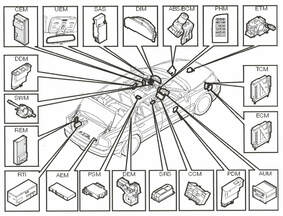1999 and newer volvos
And the infamous Check Engine Light
Starting in 1999, Volvos became much more computerized (today's Volvos have upwards of 20 different brains/computers that each perform a different function-see picture below). Along with this new technology came new requirements for shops to do diagnostics. Simply put: it takes a lot of technology to read CHECK ENGINE lights and maintain these newer cars.
|
If you're interested in a 'technical' description: Starting in 1999, OBD II was no longer the computer system for checking the Engine/Transmission/Service/ABS components. Now, it is a system called VIDA (Vehicle Information and Diagnostics for Aftersales). So, every time a "CHECK ENGINE" or "SERVICE ENGINE SOON" is displayed in the small window in the bottom left corner of the speedometer cluster, the car needs to be plugged in to a computer system. There is an interface that goes between the Volvo and a computer, then the codes are read. This software system is all web-based, and the software licensing is expensive.
|
|
The CHECK ENGINE light display is there for your protection: get the car into a shop to find out what is wrong before worse things come of it. It can come on for various reasons, and sometimes the vehicles seem to think they are smarter than they are. A good example of that is a CHECK ENGINE light will come on if the gas cap was not tightened the last time it was installed. In fairness to the car, it thinks it has a fuel system leak. I'll give it credit there, but to see that CHECK ENGINE light for something like that is certainly alarming. The biggest problem is that you (the driver) have no way of knowing if that is the reason for your light. Even getting out and checking the gas cap won't do you any good; the light will reocurr until someone uses the computer diagnostic system (VIDA) to 'read' the codes and erase them. (It sounds simple enough to tighten your gas cap every time, but those gas caps only have 2 threads to actually lock and can fail.
|
2001 Volvo C70
|
What kinds of codes do we find?
One of the most popular (I should say common) codes is related to the Catalytic Converter. Since replacing a catalytic converter is expensive, we typically read the code, erase it, and send the customer back out to see if/when the CHECK ENGINE light comes back on. Again, this is along the same line that the car sometimes thinks it is smarter than it really is.
One of the most popular (I should say common) codes is related to the Catalytic Converter. Since replacing a catalytic converter is expensive, we typically read the code, erase it, and send the customer back out to see if/when the CHECK ENGINE light comes back on. Again, this is along the same line that the car sometimes thinks it is smarter than it really is.
Even your mirror and window switches report back to computers, technically called modules. If you, or one of your passengers, has put the window down all the way and then goes back and holds the button down again, that module will store a code. It won't make the CHECK ENGINE light come on, but we know what's going on! The reason it stores a code, is a "defense system" for the car; it knows that the switch is responsible to send a signal and make something happen. When a window is already down, and you ask the switch/module to put the window further and it can't, the module thinks there is something functionally wrong. The module cannot tell the difference between "all the way down" and "not responding".
|
2003 Volvo V70XC
|
So, why should you have your CHECK ENGINE light read and the codes erased every time it is displayed?
Information can save you pain, suffering and money. Codes that indicate that the engine's temperature sensor, for example, let's us know that the cooling system is not working properly (which means severe, sometimes irreversible damage to the engine). Rather than continue to drive the car, not knowing the codes and possibly doing more damage, take it in and have the codes read. Find out if a) it is a fluke and just needs to be erased or b) indicates there is something wrong, and potential further damage will be done to the car if the problem is not repaired. |
Other service recommendations for these Volvos:
Timing Belt: Factory recommendation for 1999 models is to replace at 70,000 miles. For 2000 and newer models, the factory recommendation is 105,000 miles. We don't recommend waiting to see if the belt in your car will go the miles. Instead, with our recommended annual VMA, we check both the mileage and condition of the timing belt. If the belt shows signs of wear/cracking, we replace it (along with the pulleys and tensioners associated with it.
PCV Service: The breathing system for your car, which is often neglected for too long. Each PCV Job (Positive Crankcase Ventilation) is a little different, and not every car needs the whole work up. A blocked PCV system puts massive stress on engine seals, another service that is preventative and helps avoid potential disaster waiting to happen.
Emergency Brakes: Another little understood need of Volvo rear brakes. We have encountered examples of brakes that were recently overhauled, by another shop. However, the wheel would not turn because the emergency brake lining had, as they usually do, delaminated. This will occur whether or not the emergency brakes are used. Interestingly, the entire emergency brake system lasts much longer, and costs less over time, if the emergency brake is used.

